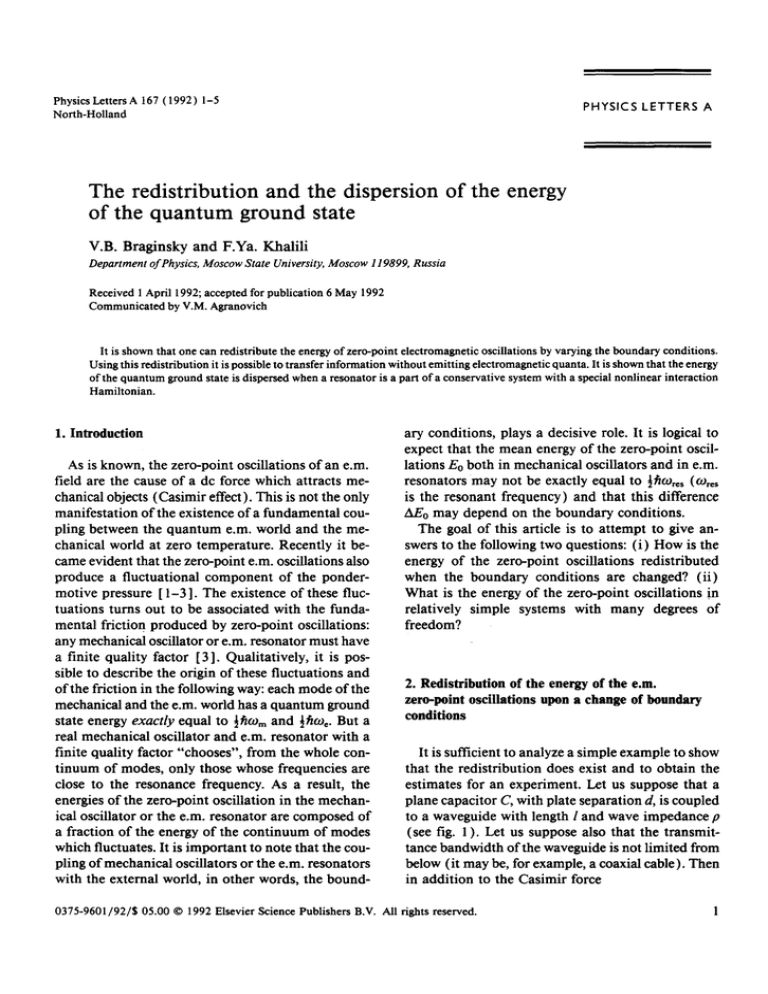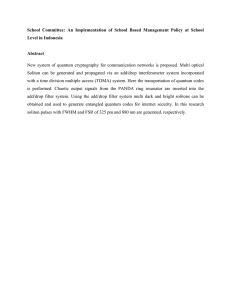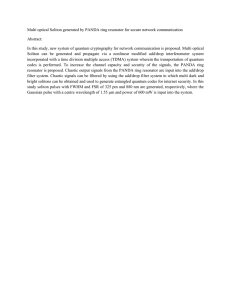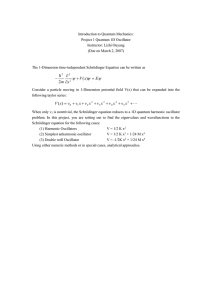
PhysicsLetters A 167 (1992) 1-5
North-Holland
PHYSICS LETTERS A
The redistribution and the dispersion of the energy
of the quantum ground state
V.B. Braginsky a n d F.Ya. Khalili
Department of Physics, Moscow State University, Moscow 119899, Russia
Received 1 April 1992;acceptedfor publication 6 May 1992
Communicatedby V.M. Agranovich
It is shown that one can redistribute the energyof zero-point electromagneticoscillationsby varyingthe boundaryconditions.
Using this redistribution it is possibleto transfer informationwithout emitting electromagneticquanta. It is shownthat the energy
of the quantum groundstate is dispersed when a resonator is a part of a conservative systemwith a special nonlinear interaction
Hamiltonian.
1. Introduction
As is known, the zero-point oscillations of an e.m.
field are the cause of a d c force which attracts mechanical objects (Casimir effect). This is not the only
manifestation of the existence of a fundamental coupling between the quantum e.m. world and the mechanical world at zero temperature. Recently it became evident that the zero-point e.m. oscillations also
produce a fluctuational component of the pondermotive pressure [ 1-3 ]. The existence of these fluctuations turns out to be associated with the fundamental friction produced by zero-point oscillations:
any mechanical oscillator or e.m. resonator must have
a finite quality factor [ 3 ]. Qualitatively, it is possible to describe the origin of these fluctuations and
of the friction in the following way: each mode of the
mechanical and the e.m. world has a quantum ground
state energy exactly equal to ½boomand ½hoJc. But a
real mechanical oscillator and e.m. resonator with a
finite quality factor "chooses", from the whole continuum of modes, only those whose frequencies are
close to the resonance frequency. As a result, the
energies of the zero-point oscillation in the mechanical oscillator or the e.m. resonator are composed of
a fraction of the energy of the continuum of modes
which fluctuates. It is important to note that the coupling of mechanical oscillators or the e.m. resonators
with the external world, in other words, the bound-
ary conditions, plays a decisive role. It is logical to
expect that the mean energy of the zero-point oscillations Eo both in mechanical oscillators and in e.m.
resonators may not be exactly equal to ½hoJ,cs (O~r~s
is the resonant frequency) and that this difference
AEo may depend on the boundary conditions.
The goal of this article is to attempt to give answers to the following two questions: (i) How is the
energy of the zero-point oscillations redistributed
when the boundary conditions are changed? (ii)
What is the energy of the zero-point oscillations jn
relatively simple systems with many degrees of
freedom?
2. Redistribution of the energy of the e.m.
zero-point oscillations upon a change of boundary
conditions
It is sufficient to analyze a simple example to show
that the redistribution does exist and to obtain the
estimates for an experiment. Let us suppose that a
plane capacitor C, with plate separation d, is coupled
to a waveguide with length l and wave impedance p
(see fig. 1 ). Let us suppose also that the transmittance bandwidth of the waveguide is not limited from
below (it may be, for example, a coaxial cable). Then
in addition to the Casimir force
0375-9601/92/$ 05.00 @ 1992 Elsevier Science Publishers B.V. All rights reserved.
1
Volume 167, number 1
PHYSICS LETTERSA
6 July 1992
voltage waves in the waveguide with impedance Po
propagating to the left (L) and to the fight (R) - in
other words, the incident and the reflected waves.
For the operator 0L(t), when T = 0 , the following
condition is valid,
/
f
Fig. 1. Coupled plane capacitor and waveguide.
k-~-]
~2hcS
FCasimi r =
240d 4 ,
( 1)
which attracts the plates with area S, an additional
force F will appear, produced by the zero-point oscillation of the eigenmodes of the system "capacitor + waveguide". The structure of these modes substantially depends on the boundary conditions on the
second end of the waveguide. As will be evident from
the calculations below, a change in the boundary
conditions produces a redistribution of the energy of
the zero-point oscillations in the system between C
and the waveguide and therefore produces a modulation of F.
It is worth to note that this will be also accompanied by a change of the mode structure in the space
around the whole system, which can also change the
value of the force acting upon the plates. Meanwhile,
it is apparent that this effect can be made negligibly
small by a reduction of the waveguide diameter.
It is convenient to assume that another, semiinfinite waveguide with wave impedance Po (in general Po¢P) is coupled to the right end of the first
waveguide. By changing the ratio r=po/p, it is possible to realize different boundary conditions. Using
the wave equations for the waveguide, it is not difficult to obtain the equations of motion for the operator of charge O(t) in the capacitor C,
O(t) _ l+r [0L(I)d. 0R(/)]
C
2r
1 - r [ 0 L ( t + 2 z ) + 0R(t--2Z) ]
2r
P
d0(t)
l + r [ 0 L ( t ) - - 0R(t) ]
dt -- 2r
_
1--r [OL(t+Ez)--Ort(t--2Z)] ,
2r
ci(co) e-i°~'do9+h.c.,
(3)
0
(2)
where z=l/v, v is the speed of the e.m. wave propagation in the waveguide, UL(t) and UR(t) are the
where h.c. is the Hermitian conjugate, ti(o9) is the
annihilation operator, which together with the creation operator 4 ÷ (co) satisfies the common commutation relation for the continuous spectrum
[ti(co), ~ ÷ (co') ] = 6 ( 0 ) - o ) ' ) .
(4)
The solution of eqs. (2) can be obtained by using
the spectral representation
O(co)=
2COL(co)
,
z(co)
(5)
where 0(co) and OL(co) are the spectra of 0(t) and
Oe( t ), respectively,
z (co) = cos coz- coZo sin ogz
+ir(sinogz+OgZo cos coz),
Zo=pC.
The attractive force between the plates of the capacitor is equal to
P't"
02(t) ,
t )= ~
(7)
and its mean value in the ground state is
hzor i codto
F(r)=<OIP(t)lO> = ~ - ~ Iz(co)12.
(8)
0
The integral in formula (8) diverges logarithmically because of the noncompleteness of the model:
at high frequencies the capacitor is not a pure capacity C but a complex multimode system. For us,
not the force F is of interest, but the difference of its
values for different factors r. On the other hand, for
physical reasons it is evident that the main contribution in the analyzed effect is made by low-frequency modes. Therefore it is possible to introduce
the cut-off frequency o90oin the integral. In the final
formulae o90ohas to disappear, and this will confirm
the correctness of this method. For r = 1 the integral
is easy to calculate directly,
Volume 167,number 1
PHYSICSLETTERSA
F( 1 ) = 4~d~o In[ 1 + (ca= Zo)2 ] .
(9)
6 July 1992
aiq.
0.10
For r--, 0 and r--, oo the integral over the continuous frequency spectrum is transformed into a sum
over the set of eigenmodes of the system,
h ,o, ~,o~o
09,
F = 2--~ .=o l + [ l + ( c a : o ) 2 1 z / T o '
tg ca.z= 1/ca.zo,
for r--,0,
(11)
tg ca, z = --ca, Zo,
for r--,oo.
(12)
The numerical calculations show that F is maximal when r = 0 and is minimal when r--,oo. This is
easy to explain because when a shortcircuit waveguide is coupled to the capacitor, the lowest eigenmode of this system corresponds to the oscillations
of the LC-circuit, the inductance of which is created
by the waveguide. In the capacitor, in this case, there
is the largest fraction (close to one half) of zero-point
oscillation energy of this mode. For other modes this
fraction is essentially smaller.
In general, the value of the difference of the attractive forces for the shortcircuit and the idle ends
of the waveguide may be presented in the following
form,
(13)
where Zfo= is a dimensionless function which depends on the length 1. The numerical calculation of
this function is presented in fig. 2a. The maximal
value ( - 0.14) of this function is reached when
l/VZo" 0.42.
In a similar way it is possible to obtain
F ( O ) - F ( 1 )=
hv
~-~/Ao,
(1/~o)
hv
,
F ( 1 ) - F ( oo ) = ~lZJ,oo( l/v'co) .
0.02
o.o~ o.I ~
o5
i ~
:
aoY at az
o
t
~
(10)
where the eigenfrequencies to. are determined from
the equations
hv
F(0)-F(oo) = ~lAoo~(l/~o),
0.06
(14)
e
~,~o
T
°'°9! b
0.03 ~
e
~-~.
Fig. 2. (a) A0= as a function of l/vzo. (b) ,Jot and ,J,® as a function of l/vro.
F ( 0 ) - F ( o o ) is of the order of O.lhc/2dl, if v = c is
the speed of the e.m. waves in vacuum. For d = 10-6
cm, 1=10 2 cm the force is -~l.5X10 -~4 dyn. The
modern methods of the measurement of the momentum permit one to detect this force if the mass
m of the plates is not too large and the mechanical
frequency Cam of the mass support is not too high. If
r n _ 10 - 9 g and if one has one order in reserve compared with the standard quantum limit [4 ], the necessary averaging time does not exceed 10 s.
It is worth to emphasize one important feature of
the discussed effect of energy redistribution: by
changing the value r experimentalists may transfer
information by the e.m. channel (which is registered
as a change in F) without emission of photons. It is
also interesting that F vanishes as l - ~.
3. Dispersion of the energy of the quantum ground
state
(15)
The functions ao~ and ,al= are presented in fig. 2b.
Now it is possible to estimate the possibility to observe this effect experimentally. As follows from formulae ( 1 2 ) - ( 1 5 ) and the numerical calculations,
The effect of the redistribution discussed above is
a static one. It is evident that any mechanical oscillations affecting the boundary conditions, and in
particular the zero-point oscillations would convert
the factor r (see section 2) into a random function
Volume 167, number 1
PHYSICS LETTERS A
of time. Due to this fact, the energy of the quantum
ground state may become not exactly defined: it is
possible to say that it may become dispersed. But in
the example discussed, this effect is small because,
first of all, the energy redistribution is also small even
when the factor r changes substantially. It is possible
to show that this effect of the dispersion of the energy of the quantum ground state of a mechanical
oscillator or an e.m. resonator can be enhanced if they
are parts of a system with several degrees of freedom,
and if in this system they are coupled in a specific
nonlinear way. In this case the dispersion effect occurs in a pure conservative system: in other words,
it is possible to neglect the coupling of each degree
of freedom with the external world and take into account only the internal coupling between them.
Let us analyze a simple example: let us suppose
that an e.m. resonator and a mechanical oscillator
with eigenfrequencies toe and tom are coupled only
via the pondermotive effect (fig. 3). Let us assume
that the inductance L and the capacity C are symmetrically coupled with the mass m (as in the socalled complete pondermotive meter [ 5 ] ). It is evident that in the ground state, if tom << tOe, the coordinate of the mass must have an uncertainty close
to Xo = ~
- the uncertainty of an isolated
oscillator. The uncertainty Xo will give the uncertainty of tOe and therefore it is reasonable to expect
the existence of an energy uncertainty AEe in the e.m.
resonator of the order of
(16)
AEe "~ ½htOexo/ d ,
where d is of the order of the capacitor plate separation. In a special optical resonator it is possible to
reach d - 10 -3 cm [6], then if m _ 1 0 - s g, tom-----10 3
S-~, the factor x o / d ~- 10 - s and AEe--- 3 × 10 - 2 0 erg.
6 July 1992
It is necessary to note that/~kEe is pertinent to a part
of the system. In the whole system "e.m. resonator+mechanical oscillator" in the quantum ground
state, the energy has a strictly defined value.
These estimates cannot be regarded as a proof of
the dispersion effect. To have a rigorous proof it is
necessary to make a more detailed analysis.
The Hamiltonian of the whole system, if xo/d<< l,
has the following form,
H=~too(~ + ½)(1-/c/d)
+ ½ ~ 2 / m + ~mtomX
~
2 ~2 ,
(17)
where toe= ( L C ) -~/2, he is the photon number operator and/c and/3 are the operators of the coordinate and the momentum of m.
It is not difficult to obtain the solutions of the
equation for the eigenstates I ~ ) of the energy,
/tl ~') = E I ~ ' ) ,
(18)
which may be written as follows,
I ~.,.m ) = e x p
m--~md 0 i e + ½ ) I n e > l n m )
•
(19)
The following eigenvalues of the energy correspond
to these solutions,
Enenm=h(.Oe(neJt-½ )-~-hO)m(nm + l )
2 2
+ 12mtomXne,
(20)
where ne and nm are the numbers of e.m. and mechanical quanta, Ine) and Into) are the corresponding states with the given number of quanta of the isolated e.m. resonator and the mechanical oscillator,
X,~ is the mean value of the shift of the coordinate
x produced by the pondermotive force,
X,,o =htoe( ne + ½) / m t o 2 d .
,'--J-"c @L
The uncertainty of the energy of the e.m. resonator
Ee =hroe(& + ½) ( l - ~ / d ) ,
L':'-----, -2==---*4
in the ground state (ne = nm = 0 ) is equal to
K -- rrz
,~
AEe = ((~'oo IE~ I ~/oo> - <~Uoolee I~'oo>2)1/2
=½ho&xo/d.
Fig. 3. Coupled e.m. resonator and mechanical oscillator.
(21)
In other words, we have obtained the same result (see
Volume 167, number 1
PHYSICS LETTERS A
formula (16)) as that obtained by the qualitative
analysis.
Analogous calculations for the uncertainty AEm of
the energy of the mechanical oscillator,
~m = ½~21m + ½rmo~;c 2 ,
give the same values as formula (21 ). It is interesting to remark that this uncertainty may be written in
the form
Z~,,,, = mtO~ xoXo .
Meanwhile, the energy of the whole system is defined exactly and is equal to
Eoo= ½hcoe+ ½~/(-t)m"~"½mO22mX~.
(22)
Thus the energy partially moves periodically from
the mechanical subsystem into the e.m. subsystem
and back, but at any moment, the energies in both
the subsystems taken separately are not defined
exactly.
It is evident that to measure these fluctuations z~tE,
one must necessarily use one of the schemes of quantum-nondemolition ( Q N D ) energy measurement
procedures (see, e.g. ref. [4] ). The sensitivity limit
of these measurements is h/2Tmea,, where r . . . . is the
measurement duration. It cannot be too long,
Tmeas< o9~ 1, because the correlation time of the fluctuations of Ee and Em is of the order of O2mI .
The energy measurement will inevitably perturb
the phase of the e.m. oscillations and as soon as Tin,as
is finite, the frequency o2¢will also be perturbed. Due
to this perturbation, a random mechanical momentum will act on the mechanical oscillator. It is easy
to show that the resulting average energy perturbation will be equal to one quantum ho2m. This is the
price for the information about the energy in the e.m.
resonator. It is important to emphasize that the e.m.
resonator will definitely remain in the ground state
because the Q N D procedure was used.
4. Conclusion
The effect described in section 2 of the redistri-
6 July 1992
bution of the energy of the quantum ground state
when the boundary conditions are changed was analyzed in a relatively simple case. It is evident that
this effect must exist in other cases and that its value
has to depend on the concrete conditions. It is important to underline that the analyzed redistribution
is a static one. Probably additional properties will
appear when the dynamic regime will be analyzed.
The dispersion of the energy of the quantum
ground state was demonstrated in the example of an
e.m. resonator which is part of the system "e.m. resonator+mechanical oscillator". This dispersion appears due to the specific Hamiltonian (nonsymmetric, nonlinear) of the interaction between the
subsystems. It is possible to obtain an analogous
Hamiltonian if one chooses two e.m. resonators coupled with a capacitor in which there is a dielectric
with a quadratic nonlinearity of the susceptibility. In
this case also energy dispersion of the quantum
ground state will occur.
We guess that these types of coupling as well as the
effect of the dispersion in fact always exist (probably
it may be a very weak one). Naturally it is possible
that it does exist for electrons in atoms. But its value
will depend on the concrete conditions: what are the
couplings of the atom with the other degrees of freedom in the atom's environment.
Acknowledgement
The authors express their gratitude to D.N.
Klyshko for valuable discussions.
References
[ 1 ] G. Barton, J. Phys. A 24 ( 1991 ) 991.
[2] G. Barton, J. Phys. A 24 ( 1991 ) 5533.
[3] V.B. Braginsky and F.Ya. Khalili, Phys. Lett. A 161 ( 1991 )
197.
[4] V.B. Braginsky, Soy. Phys. Usp. 156 (1988) 93.
[5]Yu.I. Vorontsov, Theory and methods of macroscopic
measurements (Nauka, Moscow, 1989) [in Russian ].
[ 6 ] V.B. Braginsky and S.P. Vyatchanin, Dokl. Akad. Nauk SSSR
320 (1991) 861.





